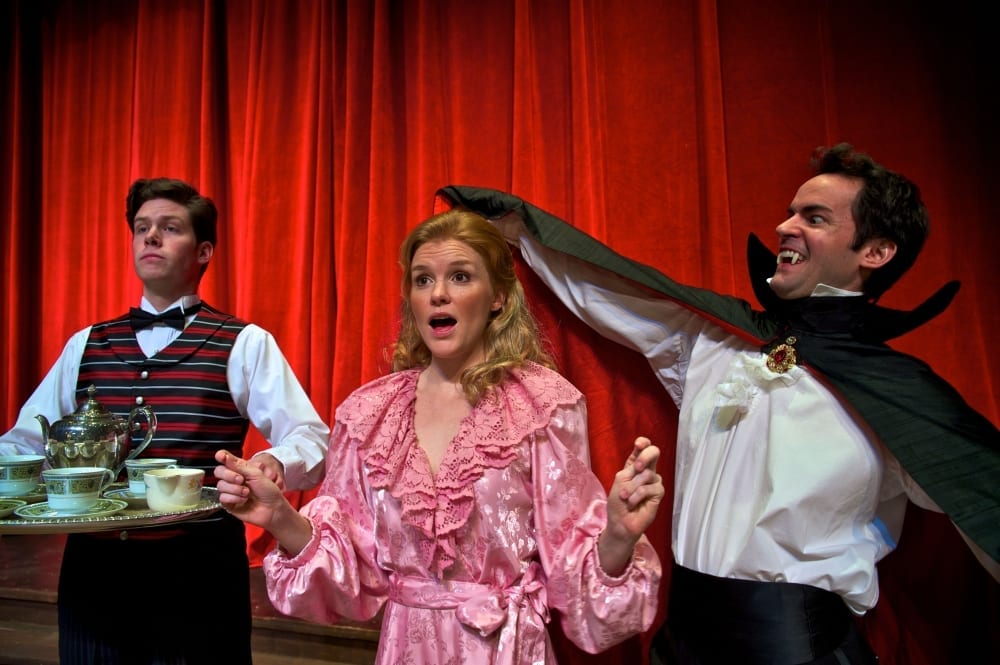SALT LAKE CITY — Laughing Stock, written and directed by Charles Morey, is a love letter to regional stock theater companies. Inspired by his own history with just such a company, Morey has written a witty, comical and endearing theater piece in the vein of Noises Off Although not as rambunctious as Noises Off, it is every bit as much fun.

Laughing Stock is set in a New England summer stock barn theater known as The Playhouse. Gordon Page, the theater’s Artistic Director (played by Jack Koenig), has scheduled a repertory season of Dracula, Hamlet and Charley’s Aunt. This unlikely group of actors and staff go from crazy auditions, to ego-driven rehearsals, and on through disastrous opening nights. They battle through limited resources, personal conflicts and seemingly insurmountable odds to produce what are, in the end, well-told stories for appreciative audiences.
I will admit from the start that I am slightly biased toward this type of show. Having acted in shows for the last 30 years, in everything from professional to community and dinner theater, I’ve seen a lot! I’m a sucker for the backstage show, like Noises Off, Waiting for Guffman or Lend Me a Tenor! These shows capture what most actors find magical about theatre: the exhilarating chaos that ensues. Everything around you can seem to be falling apart. Yet, once you step onstage, magic happens!—even if the product is less than stellar. Charles Morey has captured that lightning in a bottle here.
The acting is superb. It is such an ensemble cast that it is hard to pick out individual performances. Each actor had their own moments to shine throughout the show. I particularly enjoyed Anderson Matthews and Joyce Cohen as Richfield Hawksley and Daisy Coates, the oldest members of the Playhouse. Their characters were delightful to watch. They had some of the best moments in the show, especially Matthews during the Dracula sequence in the second act. His Van Helsing was riotous! I also loved Jeff Steitzer as Vernon. His deadpan expressions and sneering cynicism were, in contrast to his character, joyful. He practically stole one scene merely by his facial expression alone. Lesley Shires as Mary was also a delight. Her Southern drawl and delightfully dim character were great fun to watch. Her “audition” with Ophelia’s soliloquy is priceless. I would love to spotlight each actor, but I fear that would give too much away from the show.
The set design by Peter Harrison was excellent and I loved how they were able to make the “rehearsal barn” become the “performance barn.” You’ll need to see the show to fully appreciate that. All the production elements (costume design by K. L. Alberts, lighting design by Karl Haas, sound design by Matthew Tibbs, and hair and makeup design by Amanda French) were well executed, and contributed to the wonderful look of this show. One slight distraction was the use of recordings for some backstage elements. These at times were distracting and took me out of the moment.
I loved this production. I have seen both good and bad at Pioneer Theatre Company over the years. This truly is one of the highlights of all the shows I’ve seen there. If you have any connection to theatre (and if you don’t, why are you here?) you must see this show. I laughed until I cried, then laughed again at home describing the show to my kids. From beginning to end this show delights.
[box type=”shadow”]Laughing Stock plays in the Simmons Pioneer Memorial Theatre at Pioneer Theatre Company (300 S. 1400 E., Salt Lake City; on the campus of the University of Utah) through April 7th. Tickets are $25-$49 when purchased in advance. For more information, visit pioneertheatre.org.[/box]

